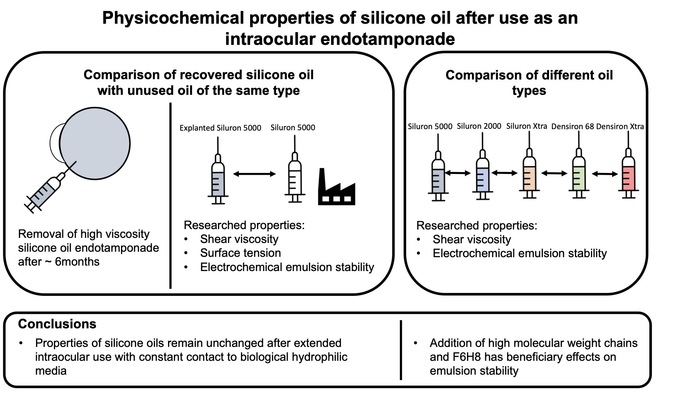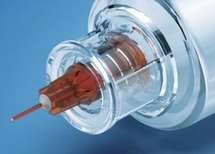Heidelberg, 6 February 2022.
We are happy to share that a research paper from the David J Apple Laboratory was recently published in the prestigious journal of Translational Vision Science and Technology. The study focused on the physicochemical parameters of silicone oil after its use as an intraocular tamponade in retinal detachment surgery.
Background
The use of silicone oil is widespread in the world of retinal surgery. However, its use comes with critical downsides: complications that arise from the oil’s potential to emulsify, and when this stage is reached the oil has to be explanted. While parameters, such as the shear stress during the eye’s movement, are already identified as potential risk factors for emulsification, the contamination of the oil over time in the eye with lipophilic and amphiphilic substances has not yet been researched.
What we did
We examined the properties of explanted silicone oil from 15 patients after a clinically relevant mean duration of 6 months within the eye. We compared the explanted oils’ viscosity, surface tension, and zeta potential (a measure for an emulsion’s electrochemical stability) to control unused silicone oil samples.
What we found
 The long duration does not alter the parameters of the oils within the eye, and this information further stresses the oil-aqueous interface as the prime source of emulsification. Additionally, the current trend of manufacturers adding high molecular weight components to improve the endotamponade effect of silicone oil seems also to have beneficial effects on the oils’ electrochemical emulsion stability.
The long duration does not alter the parameters of the oils within the eye, and this information further stresses the oil-aqueous interface as the prime source of emulsification. Additionally, the current trend of manufacturers adding high molecular weight components to improve the endotamponade effect of silicone oil seems also to have beneficial effects on the oils’ electrochemical emulsion stability.
 Prof. Gerd Auffarth commented. “This study of explanted silicone oils may, at first sight, look like a completely new area of research for our lab but in practice, we applied the same analytical strategy that the Apple Lab so successfully applied in dealing with explanted opacified IOLs. We look at Silicone oil as an implant device just as much as the IOL is an implantable device. A device can fail, and then it has to be explanted. The questions we had, say twenty years ago about IOL opacification (how long does it take to occur, what causes it, and how to prevent it?) these same questions arise too with Silicone oil emulsification. In both cases, what we are investigating is device failure. David Apple would have been fascinated by this continuation in the investigational approach: the Apple Lab moving smoothly from lenses to research on liquids.”
Prof. Gerd Auffarth commented. “This study of explanted silicone oils may, at first sight, look like a completely new area of research for our lab but in practice, we applied the same analytical strategy that the Apple Lab so successfully applied in dealing with explanted opacified IOLs. We look at Silicone oil as an implant device just as much as the IOL is an implantable device. A device can fail, and then it has to be explanted. The questions we had, say twenty years ago about IOL opacification (how long does it take to occur, what causes it, and how to prevent it?) these same questions arise too with Silicone oil emulsification. In both cases, what we are investigating is device failure. David Apple would have been fascinated by this continuation in the investigational approach: the Apple Lab moving smoothly from lenses to research on liquids.”
In summary
While Silicone oil emulsification remains a problem that needs to be solved, we consider our study is the first to introduce electrochemical emulsion stability as a parameter to look out for when researching emulsification.
To read our paper
Our paper is open access, to download it please follow this link
https://tvst.arvojournals.org/article.aspx?articleid=2778342&resultClick=1
How to cite our paper
Maximilian Hammer, Sonja Schickhardt, Donald J. Munro, Alexander Scheuerle, Christian S. Mayer, Gerd U. Auffarth; Physicochemical Properties of Explanted Silicone Oil After Use as an Intraocular Tamponade. Trans. Vis. Sci. Tech. 2022;11(2):3. doi: https://doi.org/10.1167/tvst.11.2.3.
end
 Maximilian Hammer
Maximilian Hammer 
 Polyimide cannulas
Polyimide cannulas